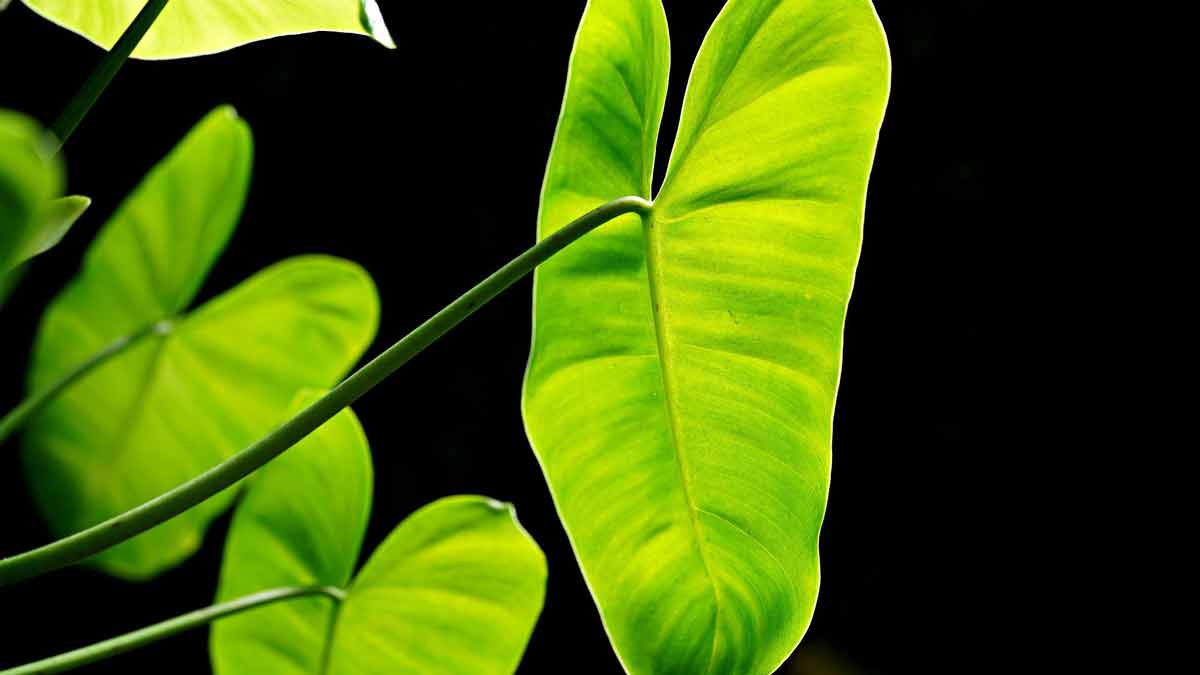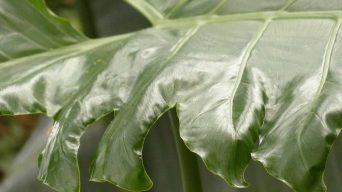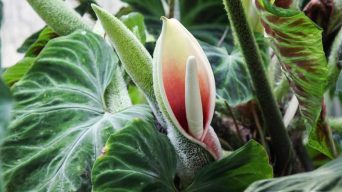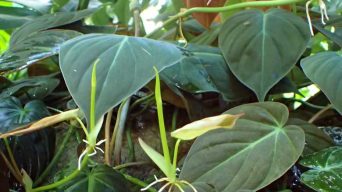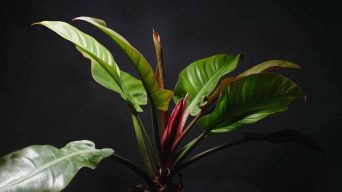Philodendron plants are native to the tropical regions of South America.
They are known for their large, glossy leaves and vining habit.
Some species can grow quite large, while others remain small enough to be grown in pots.
Philodendrons are popular houseplants because they are relatively easy to care for.
Philodendron leaves may drip water for a variety of reasons.
In most cases, there is nothing to worry about, and the plant responds to its environment.
However, if other symptoms accompany philodendron leaves dripping water, it may be a sign of a problem.
You will find everything you need to know about why philodendrons leaves drip water and what you can do about it.
Why Do Philodendron Leaves Drip Water?
There are a few reasons why philodendron leaves may drip water.
The most common reasons are transpiration and guttation.
Transpiration
Transpiration is the process of water evaporating from the leaves of a plant.
It is a normal and necessary process that helps to regulate the plant’s temperature and keep it cool.
During transpiration, water molecules move from the inside of the leaves to the outside.
As they do so, they evaporate into the air, which helps to cool the plant, causing the leaves to drip water.
Transpiration also helps the plant absorb nutrients from the soil and eliminate waste products.
This usually occurs during the daytime when the temperature is warm and the air is dry.
The rate of transpiration can be affected by several factors, including the weather, the type of plant, and the amount of light it receives.
Can Transpiration Be Bad for Plants?
While transpiration is a necessary and normal process, there are times when it can be detrimental to the plant.
For example, if the air is too dry, the plant will lose more water than it can replace and may become dehydrated.
If the temperature is too hot, the plant will lose more water than it can replace.
In either scenario, the plant will experience wilting, and the philodendron leaves will be discolored, appearing yellow.
It is essential to ensure that your plant gets enough water to replace the water it is losing through transpiration.
An easy way to do this is to check the soil before watering.
If the soil is dry, it is time to water the plant.
Guttation
Guttation is another process that can cause philodendron leaves to drip water.
It occurs when the plant’s roots absorb more water than the plant can use, and the excess water is secreted through the leaves.
Guttation usually occurs at night or early morning when the air is cool and humid.
It is a normal process that helps to regulate the plant’s water intake.
Guttation also helps the plant to get rid of any excess nutrients it may have absorbed from the soil.
It is more common in plants recently watered or growing in moist soil.
Can Guttation Be Bad for Plants?
Guttation is a normal and necessary process, but sometimes it can be detrimental to the plant.
For example, if the plant absorbs more water than it can, the excess water will pressure the plant’s cells and cause them to burst.
This can lead to the leaves wilting, turning yellow or brown, and eventually falling off the plant.
If you notice that your plant is losing leaves, it is essential to check the root system to ensure it is not overwatered.
How to Tell the Difference Between Guttation and Dew
Guttation is easily mistaken for dew, as both can cause the leaves of a plant to drip water.
However, there are a few key differences between the two.
Dew is caused by condensation when water vapor in the air turns into liquid water.
This usually occurs at night or in the early morning when the temperature is cool and the air is humid.
Dew will usually form on the surface of the leaves, whereas guttation will occur at the tips or edges of the leaves.
Another key difference is that dew usually evaporates during the day, whereas guttation does not.
If you’re still unsure whether your plant is experiencing guttation or dew, you can simply touch the water on the leaves.
If it is dew, it will be cool to the touch. If it is guttation, it will be warm.
How to Tell If Your Philodendrons Leaves Dripping Water Is Normal or Not
If you notice that your philodendron’s leaves are dripping water, it is essential to determine whether or not it is normal.
There are a few key things to look for that will help you make this determination.
First, check the weather conditions. If it has been warm and dry, the indoor plant will likely transpire.
The plant is likely gutting if it has been cool and humid.
Second, check the soil. If the plant has been recently watered or grows in moist soil, guttation is more likely.
Finally, check the plant leaves. If the water is dripping from the tips or edges of the leaves, it is most likely guttation.
If the water is dripping from the surface of the leaves, then it is more likely to be dew.
Even though both transpiration and guttation are normal processes, there are times when they can be detrimental to the plant.
If you also notice that the plant is wilting, its leaves are turning yellow or brown, or it is losing leaves, then something is likely wrong.
There are several possible causes of this, including:
1. Overwatering
Overwatering is one of the most common causes of wilting, yellowing, or browning leaves.
If you notice that your indoor plant is wilting or its leaves are turning yellow or brown, it is essential to check the root system to ensure that it is not overwatered.
Overwatering occurs when the plant is taking in more water than it can use.
This can happen for a variety of reasons, including:
- The plant is not getting enough sunlight
- The soil is too dense
- The pot doesn’t have proper drainage
- You are watering the plant too often
Overwatering can cause philodendron leaves to drip water because the plant takes in more water than it can use.
This causes the plant to put pressure on its cells, leading to the leaves wilting, turning yellow or brown and eventually falling off.
To prevent an overwatered philodendron, make sure to:
- Check the plant’s root system regularly to make sure it is not waterlogged
- Allow the soil to dry out between watering
- Use a well-draining pot with drainage holes
- Water the plant deeply, but less often
2. Underwatering
Underwatering is another common cause of wilting, yellowing, or browning leaves, in addition to water droplets on leaves.
Underwatering occurs when the plant is not getting enough water.
This can happen for a variety of reasons, including:
- The soil is too dry
- The pot doesn’t have proper drainage
- You are not watering the plant often enough
Underwatering can cause plant leaves to drip water because the plant is trying to compensate for the lack of water by drawing water from the leaves.
This causes the leaves to droop, turn yellow or brown, and eventually fall off.
To prevent an underwatered philodendron, make sure to:
- Water the plant when the top inch of soil is dry
- Use a pot with proper drainage
- Do not let the plant sit in water
3. High Humidity
High humidity can also cause philodendron leaves to drip water.
While high humidity is generally good for plants, it can cause problems if the air is too saturated with water.
This can happen if the plant is:
- Growing in a pot that doesn’t have proper drainage
- Being watered too often
- Sitting in a saucer of water
When the air is too saturated with water, it can cause the plant to transpire more than usual.
This can lead to the leaves dripping water as the plant tries to regulate its water intake.
To prevent high humidity from causing problems, make sure to:
- Use a pot with proper drainage
- Allow the soil to dry out between watering
- Provide the plant with adequate airflow
4. Hot, Dry Conditions
Hot, dry conditions can also cause philodendron leaves to drip water.
When the air is hot and dry, it can cause the plant to transpire more than usual.
This can lead to the leaves dripping water as the plant tries to regulate its water intake.
To prevent hot, dry conditions from causing problems, make sure to:
- Provide the plant with adequate airflow
- Mist the leaves regularly
- Group plants together to create a humid microclimate
- Use a humidity tray or pebble tray
5. Root Rot
Root rot is another possible cause of wilting, yellowing, or browning leaves.
Root rot occurs when the roots of the plant are not getting enough oxygen.
This can happen for a variety of reasons, including:
- The pot doesn’t have proper drainage
- The soil is too dense
- The plant is getting too much water
Root rot can cause philodendron leaves to drip water because the plant cannot absorb enough water.
This can lead to the leaves wilting, turning yellow or brown, and eventually falling off.
To prevent root rot, make sure to:
- Use a well-draining pot with drainage holes
- Allow the soil to dry out between watering
- Do not water the plant too often
- Check the roots regularly for signs of rot
If you suspect your philodendron has root rot, it is essential to take action immediately.
Root rot can spread quickly and kill the plant.
If you catch it early, you may be able to save the plant by replanting it in a fresh potting mix.
What Can I Do About Philodendron Leaves Dripping Water?
If you think your plant is dripping water for one of the reasons listed above, you can do a few things to help.
1. Water Deeply and Less Often
If you think your plant is dripping water because of overwatering, the best thing to do is to water deeply and less often.
Water the plant until the soil is saturated, and then allow the top inch of soil to dry out before watering again.
2. Use a Pot with Proper Drainage
If you think your plant is dripping water because of poor drainage, the best thing to do is to use a pot with proper drainage.
Ensure the pot has drainage holes in the bottom so excess water can drain out.
3. Provide Adequate Airflow
If you think your plant is dripping water because of high humidity or hot, dry conditions, providing adequate airflow is best.
Make sure the plant has plenty of space around it and that there is good air circulation.
You can also mist the leaves regularly to help increase humidity.
4. Ensure the Soil is Well-Draining
If you think your plant is dripping water because of root rot, the best thing to do is to ensure the soil is well-draining.
A well-draining potting mix will help to prevent the roots from sitting in water.
You can also replant the plant in a fresh potting mix if you think the current mix is too dense.
5. Cut Back on Fertilizer
Overfertilization can also cause philodendron leaves to drip water.
When a plant is fertilized too often, it can damage the roots and cause the plant to be unable to take in water properly.
If you think your plant is dripping water because of overfertilization, the best thing to do is to cut back on fertilizer.
Only fertilize the plant when it is actively growing and use a half-strength solution.
6. Move the Plant to a Cooler Location
If you think your plant is dripping water because of hot, dry conditions, moving the plant to a cooler location is best.
Place the plant in an area with indirect sunlight and good air circulation.
You can also mist the leaves regularly to help increase humidity.
7. Check the Roots
If you think your plant is dripping water because of root rot, the best thing to do is to check the roots.
If the roots are brown and mushy, they may be rotted.
You can try to save the plant by replanting it in a fresh potting mix.
Final Thoughts
Philodendron plants are beautiful, easy to care for and make great houseplants.
They are known for their ability to purify the air and make a great addition to any home. However, some people may notice that their philodendron leaves are dripping water.
This can be alarming, but it is usually nothing to worry about.
Two main reasons your philodendron’s leaves may be dripping water are transpiration and guttation.
Transpiration is a normal process that helps the plant regulate its temperature and humidity levels.
Guttation is when the plant releases excess water through the leaf tips.
If you notice your philodendron’s leaves are dripping water, it is probably due to one of these two processes.
However, if the leaves are dripping water and the plant is wilting, this could be a sign that something is wrong.
You’ll need to determine the cause to take the appropriate action.
With some care, your philodendron plant should return to its healthy self in no time.

